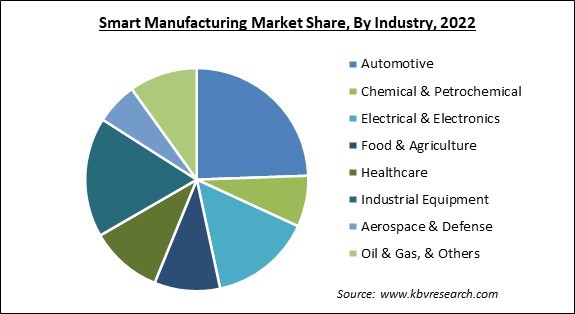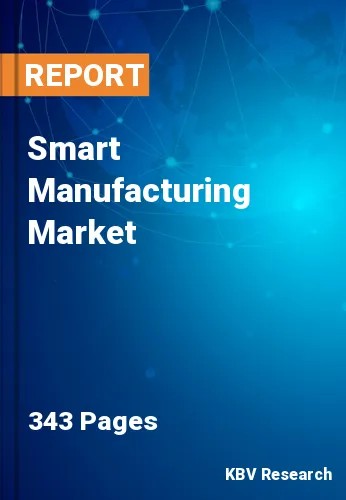The Global Smart Manufacturing Market size is expected to reach $576.3 billion by 2029, rising at a market growth of 12.2% CAGR during the forecast period.
Plant Asset Management is the growing application of smart manufacturing as it increases market development by minimizing waste and downtime in industrial processes. Smart technology utilization is also predicted to help businesses simplify their supply chains to improve competitiveness. Hence, Plant Asset Management captured $11,423 million revenue of the market in 2022.

The major strategies followed by the market participants are Partnerships as the key developmental strategy to keep pace with the changing demands of end users. In November, 2022, Fanuc came into collaboration with LG Uplus for jointly developing a smart factory platform. Through this collaboration, the companies aim at monitoring equipment status and discovering any abnormalities. Additionally, In August, 2020, Honeywell collaborated with Halliburton for maximizing the asset potential, lowering the execution risk, and reducing the total cost of ownership for the oil & gas operators. This collaboration would enable the companies' customers to gain deep insights and visibility into their operations.
Based on the Analysis presented in the Cardinal matrix; Honeywell International, Inc., Rockwell Automation, Inc., and Siemens AG are the forerunners in the Market. In October, 2022, Siemens partnered with ADMARES for deploying Siemens' software in designing and building ADMARES smart factories. Companies such as Emerson Electric Co., ABB Ltd, and Schneider Electric SE are some of the key innovators in Market.

The IoT-based applications used in smart manufacturing are set to change with the advent of the 5G era. Particularly in latency, reliability, security, scalability, and the degree of individual control on connectivity parameters, 5G can have a revolutionary effect on how future IoT ecosystems are structured. Additionally, as the scope of IoT application areas expands, more complex use cases necessitating improved network abilities are also appearing. Such features include supporting integrated sensors, improved placement, and swift device mobility. Therefore, advancing communication technologies like 5G are a significant element fueling the growth of the market.
As governments throughout the world become increasingly aware of the enormous opportunities presented by smart manufacturing technologies, they are supporting and funding research and development for technologies such as industrial internet of things and industrial 3D printing. As they anticipate becoming future consumers of the technology, the governments of several nations are encouraging IIoT innovation. Moreover, to create and manage smart cities in the future, they are investing in new IoT research initiatives and implementations. To further explore the potential of 3D printing technology, governments worldwide are launching initiatives and sponsoring groups that work in research, education, and technology. Hence, the increasing support for smart manufacturing is aiding in their adoption by most businesses, which is propelling the development of the market.
One of the primary obstacles to adoption is the large initial expenditure required to integrate smart manufacturing technologies. Technologies like IoT sensors, automation, and big data analytics require significant infrastructure, hardware, and software investments. The installation and implementation of smart manufacturing technologies such as automated guided vehicles (AGVs), human machine interfaces (HMI), enterprise manufacturing intelligence (EMI), and production asset management (PAM) require a sizeable amount of capital. It's possible that this will discourage companies from embracing smart manufacturing. Hence, the high cost of implementation of smart manufacturing prevents the market from growing rapidly.
Based on component, the market is characterized into hardware, software, and services. The software segment procured a considerable growth rate in the market in 2022. The industry's backbone is its software component, which is driving it toward complete automation. Drones, robots, and other machinery will be operated by cutting-edge software, decreasing the possibility of any errors. The software enables the market to advance significantly in its drive for fresher, more adaptable solutions.
By industry, the market is divided into automotive, aerospace & defense, chemicals & petrochemical, healthcare, industrial equipment, electrical & electronics, food & agriculture, oil & gas, and others. The automotive segment procured the maximum revenue share in the market in 2022. Manufacturers always strive to increase productivity, lower costs, and improve product quality in the fiercely competitive and ever-evolving automobile sector. The automobile sector uses robotics and automation to boost productivity, save labor costs, and increase safety. Robots are employed to complete jobs like welding, painting, and assembling, and automated guided vehicles (AGVs) are utilized to move materials and components across the factory floor.

On the basis of application, the market is classified into machine execution system, programmable logic controller (PLC), supervisory control and data acquisition (SCADA), enterprise resource planning, discrete control systems, human-machine interface (HMI), machine vision & machine condition monitoring, 3D printing, product lifecycle management, plant asset management, and others. The 3D printing segment recorded a significant revenue share in the market in 2022. Smart manufacturers may now design any tiny or large part in 3D software because of 3D printing. A smart manufacturing facility can quickly and cheaply design and print 3D models because of its ease of use. As a result, the market is a significant investor in and buyer of 3D printing hardware and software.
| Report Attribute | Details |
|---|---|
| Market size value in 2022 | USD 262 Billion |
| Market size forecast in 2029 | USD 576.3 Billion |
| Base Year | 2022 |
| Historical Period | 2019 to 2021 |
| Forecast Period | 2023 to 2029 |
| Revenue Growth Rate | CAGR of 12.2% from 2023 to 2029 |
| Number of Pages | 349 |
| Number of Table | 484 |
| Report coverage | Market Trends, Revenue Estimation and Forecast, Segmentation Analysis, Regional and Country Breakdown, Competitive Landscape, Companies Strategic Developments, Company Profiling |
| Segments covered | Component, Application, Industry, Region |
| Country scope | US, Canada, Mexico, Germany, UK, France, Russia, Spain, Italy, China, Japan, India, South Korea, Singapore, Malaysia, Brazil, Argentina, UAE, Saudi Arabia, South Africa, Nigeria |
| Growth Drivers |
|
| Restraints |
|
Region wise, the market is analyzed across North America, Europe, Asia Pacific, and LAMEA. The Asia Pacific segment garnered the highest revenue share in the market in 2022. With many businesses making significant R&D investments, the Asia Pacific region is a center for innovation and technical development. Modern smart manufacturing technologies have emerged, including robotics, AI, and the IoT. There is an increasing demand for cybersecurity tools to defend against online threats as linked and digital smart manufacturing systems advance. As a result, there is a chance for businesses to create cutting-edge solutions that can offer reliable cybersecurity protection for numerous smart manufacturing systems.
Free Valuable Insights: Global Smart Manufacturing Market size to reach USD 576.3 Billion by 2029
The market research report covers the analysis of key stake holders of the market. Key companies profiled in the report include ABB Ltd, Siemens AG, General Electric Company, Rockwell Automation, Inc., Schneider Electric SE, Honeywell International, Inc., Emerson Electric Co., FANUC Corporation, IBM Corporation, and Stratasys, Ltd.
By Application
By Component
By Industry
By Geography
The Market size is projected to reach USD 576.3 billion by 2029.
Increasing level of government support for smart manufacturing are driving the Market in coming years, however, Requirement for significant financial commitments and expenses restraints the growth of the Market.
ABB Ltd, Siemens AG, General Electric Company, Rockwell Automation, Inc., Schneider Electric SE, Honeywell International, Inc., Emerson Electric Co., FANUC Corporation, IBM Corporation, and Stratasys, Ltd.
The Hardware market acquired the maximum revenue share in the Market by Component in 2022 thereby, achieving a market value of $236 billion by 2029.
The Electrical & Electronics market has shown the high growth rate of 13.2% during (2023 - 2029).
The Asia Pacific market dominated the Market by Region in 2022 and would continue to be a dominant market till 2029; thereby, achieving a market value of $213.9 billion by 2029.
Our team of dedicated experts can provide you with attractive expansion opportunities for your business.

